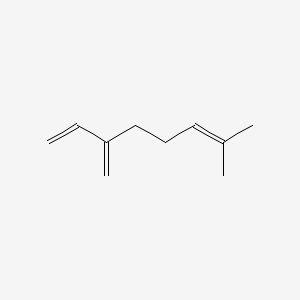| Authors | Title | Published | Journal | PubMed Link |
|---|---|---|---|---|
| Tschiggerl C and Bucar F | Investigation of the volatile fraction of rosemary infusion extracts. | 2010 Jul-Sep | Sci Pharm | pmid:21179360 |
| NTP technical report on the toxicology and carcinogenesis studies of beta-myrcene (CAS No. 123-35-3) in F344/N rats and B6C3F1 mice (Gavage studies). | 2010 | Natl Toxicol Program Tech Rep Ser | pmid:21415873 | |
| Thompson ML et al. | Biotransformation of beta-myrcene to geraniol by a strain of Rhodococcus erythropolis isolated by selective enrichment from hop plants. | 2010 | Appl. Microbiol. Biotechnol. | pmid:19707757 |
| Rivoal A et al. | Environmental control of terpene emissions from Cistus monspeliensis L. in natural Mediterranean shrublands. | 2010 | Chemosphere | pmid:20092868 |
| Martin DM et al. | Functional annotation, genome organization and phylogeny of the grapevine (Vitis vinifera) terpene synthase gene family based on genome assembly, FLcDNA cloning, and enzyme assays. | 2010 | BMC Plant Biol. | pmid:20964856 |
| Kunwar RM et al. | Traditional herbal medicine in far-west Nepal: a pharmacological appraisal. | 2010 | J Ethnobiol Ethnomed | pmid:21144003 |
| Martini A et al. | The influence of pine volatile compounds on the olfactory response by Neodiprion sertifer (Geoffroy) females. | 2010 | J. Chem. Ecol. | pmid:20809142 |
| Tawaha K and Hudaib M | Volatile oil profiles of the aerial parts of Jordanian garland, Chrysanthemum coronarium. | 2010 | Pharm Biol | pmid:20818927 |
| Sõukand R et al. | Uninvited guests: traditional insect repellents in Estonia used against the clothes moth Tineola bisselliella, human flea Pulex irritons and bedbug Cimex lectularius. | 2010 | J. Insect Sci. | pmid:21070174 |
| Paris CI et al. | Changes in monoterpene emission rates of Quercus ilex infested by aphids tended by native or invasive Lasius ant species. | 2010 | J. Chem. Ecol. | pmid:20549328 |
Myrcene
Myrcene is a lipid of Prenol Lipids (PR) class. Myrcene is associated with abnormalities such as Hypomenorrhea, abnormal fragmented structure, Nephrosis, Renal tubular disorder and Kidney Diseases. The involved functions are known as Anabolism, Gene Expression, Protein Biosynthesis, Mutation and Selection, Genetic. Myrcene often locates in Plastids, Proboscis, Body tissue, Clone and soluble. The associated genes with Myrcene are TTPA gene, monoterpene synthase, Genome, 4S-limonene synthase and Homologous Gene. The related lipids are Pinene, Octanols, Membrane Lipids and Fatty Acids, Unsaturated.
Cross Reference
Introduction
To understand associated biological information of Myrcene, we collected biological information of abnormalities, associated pathways, cellular/molecular locations, biological functions, related genes/proteins, lipids and common seen animal/experimental models with organized paragraphs from literatures.
What diseases are associated with Myrcene?
Myrcene is suspected in Nephrosis, Kidney Diseases, Dehydration, Hypomenorrhea, Renal tubular disorder and other diseases in descending order of the highest number of associated sentences.
Related references are mostly published in these journals:
| Disease | Cross reference | Weighted score | Related literature |
|---|
No disease MeSH terms mapped to the current reference collection.
PubChem Associated disorders and diseases
What pathways are associated with Myrcene
There are no associated biomedical information in the current reference collection.
PubChem Biomolecular Interactions and Pathways
Link to PubChem Biomolecular Interactions and PathwaysWhat cellular locations are associated with Myrcene?
Visualization in cellular structure
Associated locations are in red color. Not associated locations are in black.
Related references are published most in these journals:
| Location | Cross reference | Weighted score | Related literatures |
|---|
What functions are associated with Myrcene?
Related references are published most in these journals:
| Function | Cross reference | Weighted score | Related literatures |
|---|
What lipids are associated with Myrcene?
Related references are published most in these journals:
| Lipid concept | Cross reference | Weighted score | Related literatures |
|---|
What genes are associated with Myrcene?
Related references are published most in these journals:
| Gene | Cross reference | Weighted score | Related literatures |
|---|
What common seen animal models are associated with Myrcene?
There are no associated biomedical information in the current reference collection.
